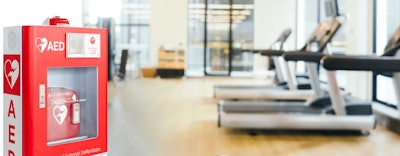
Athletic Business has been examining the question of whether health and fitness clubs have a legal duty to have an automated external defibrillator (AED) on site as far back as April 2007. Over the past 14 years, some states have moved to require health facilities to have an AED on site, but not every state has been willing to impose such a duty.
In fact, as of December 2020, there were only 16 states — Arkansas, California, Connecticut, Illinois, Indiana, Iowa, Louisiana, Maryland, Massachusetts, Michigan, New Jersey, New York, Nevada, Oregon, Pennsylvania and Rhode Island — as well as the District of Columbia that had mandated AED placement in health clubs, though most exempt spas in hotels. Even in some of the states that require facilities to have an onsite AED, there is still some confusion as to whether the facilities have a legal duty to actually use it.
A good example of this apparent disconnect is Dawkins v. Fitness International, 2020 Ill. App. Unpub. LEXIS 2100.
A duty to use?
While exercising at a fitness facility in Oswego, Ill., Dollett Smith Dawkins collapsed and stopped breathing. Although the club's staff members were aware of Dawkins' medical emergency, they failed to act. In particular, an employee on the premises at the time was trained to use the facility's AED but did not immediately use it on Dawkins — instead waiting more than eight minutes before employing the device. As a result of the delay, Dawkins suffered a permanent brain injury due to the lack of oxygenated blood to the brain.
Dawkins sued Fitness International LLC, L.A. Fitness, and L.A. Fitness Oswego for negligence claiming that the employees' failure to use the AED in a timely fashion after she suffered cardiac arrest was in violation of the Illinois Physical Fitness Facility Medical Emergency Preparedness Act. The PFFMEPA required the club to 1) have a functioning AED on site, 2) have staff properly trained in the assessment of patrons and the use of AEDs, 3) have properly trained staff who were required to know to assess patrons who became unconscious for signs of breathing, pulse and circulation in preparation for employing an AED device, and 4) have a medical emergency plan for responding to medical emergencies.
The club, however, argued that the PFFMEPA only required that facilities have a medical emergency plan filed with the Illinois Department of Public Health (IDPH), an AED on the premises, and a trained AED on staff during business hours. Therefore, the club argued that it was in full compliance with the PFFMEPA at the time of Dawkins' injuries. In particular, the club argued that the PFFMEPA created no duty to use an AED.
In agreeing with the club, the trial court held that the PFFMEPA did not create a duty for employees to use the AED, but only required that clubs have an AED on the premises, with an emergency plan in place.
Dawkins appealed the lower court's decision to the Appellate Court of Illinois, Third District. In the appeal, Dawkins argued that the intent of the PFFMEPA was to create a duty for fitness facility staff members who are properly trained in the use of an AED to use it under appropriate circumstances. In support of this position, Dawkins pointed to Section 5 of the AED Act, which states that "timely attention in medical emergencies saves lives, and that trained use of [AEDs] in medical emergency response can increase the number of lives saved."
In overturning the lower court's decision, the Appellate Court held that it was undeniable that the PFFMEPA requires that a fitness facility have a functioning AED on its premise and a staff member or members properly trained to use an AED present at each fitness facility during business hours. These requirements, the Appellate Court held, clearly suggest that the Illinois Legislature intended to impose a duty on properly trained staff to assess unconscious patients and to use the AED when appropriate.
Plain words, common sense
In rejecting the club's argument, the Appellate Court found that its interpretation was contrary to the plain words of the PFFMEPA, which states that "[a] right of action does not exist in connection with the use or non-use of an [AED] at a facility governed by this Act, except for willful or wanton misconduct." This sentence, the court held, unambiguously provides that civil liability not merely for the misuse of an AED but also the failure to use an AED, provided that such failure is willful and wanton. In addition, the Appellate Court held that the club's reading of the law would also negate the expressed purpose of the statute, which is to protect patrons of fitness facilities and to save lives by encouraging the proper use of AEDs.
Based on the club's reading, a fitness facility could fully comply with the PFFMEPA by having a functioning AED on site, training a staff member in its use, and developing an emergency medical plan, without having any obligation to implement the plan or to have the trained employee use the AED on a stricken patron under any circumstances. This interpretation, the court held, flouts the plain language of the statute and common sense, and would render it absurd, pointless or ineffectual.
As for the club's last argument — that even if there was a duty, Dawkins failed to adequately allege willful and wanton misconduct — the Appellate Court, in sending the case back to the lower court, held that a willful or wanton injury must have been intentional, or the act must have been committed under circumstances exhibiting reckless disregard for the safety of others. This would include, after knowledge of an impending danger, a failure to exercise ordinary care to prevent it.
It was therefore up to the jury to determine whether the failure of the club's employees to render AED treatment to Dawkins for more than eight minutes after she collapsed and had no signs of breathing, circulation or a pulse amounted to willful and wanton conduct that breached a duty that L.A. Fitness owed to Dawkins and proximately caused her injuries.
Reasonable burden
Although the Appellate Court's decision only sent the case back to the lower court, it still provides several lessons for health and fitness club owners.
First, in those states that have laws requiring AEDs, merely having one and an emergency plan is not enough. Even if the law does not say the club has a duty to use the AED to help people in the club in distress, it is important that health and fitness facilities not only plan for all possible emergency situations, but make sure that their employees are ready to implement those plans in an emergency. The longer employees wait before implementing the plan, the greater the risk of permanent injury or death.
Second, in those states without AED laws creating a statutory duty to use an AED, facilities may still be negligent under common law. In deciding whether a club owes their guests a duty under common law, the court considers 1) whether the plaintiff's injury was reasonably foreseeable, 2) the likelihood of injury, 3) the magnitude of the burden of guarding against injury, and 4) the consequences of placing a burden on the defendant. Considering these factors, and the fact that more than 356,000 out-of-hospital cardiac arrests occur annually in the United States, it would be reasonable for a court to find that it is foreseeable that patrons could suffer cardiac events while exercising in a fitness center.
Finally, when weighing the burden on the club of guarding against such injuries vis-a-vis the potential for a guest's death, the burden placed on the club is reasonable. A patron suffering cardiac arrest is rendered helpless and in grave danger. A trained AED user at a fitness facility is in a far better position to care for such patrons than are other patrons or the stricken individuals themselves.
This article originally appeared in the April 2021 issue of Athletic Business with the title "Is having an AED enough to keep clubs off the hook?." Athletic Business is a free magazine for professionals in the athletic, fitness and recreation industry. Click here to subscribe.
































